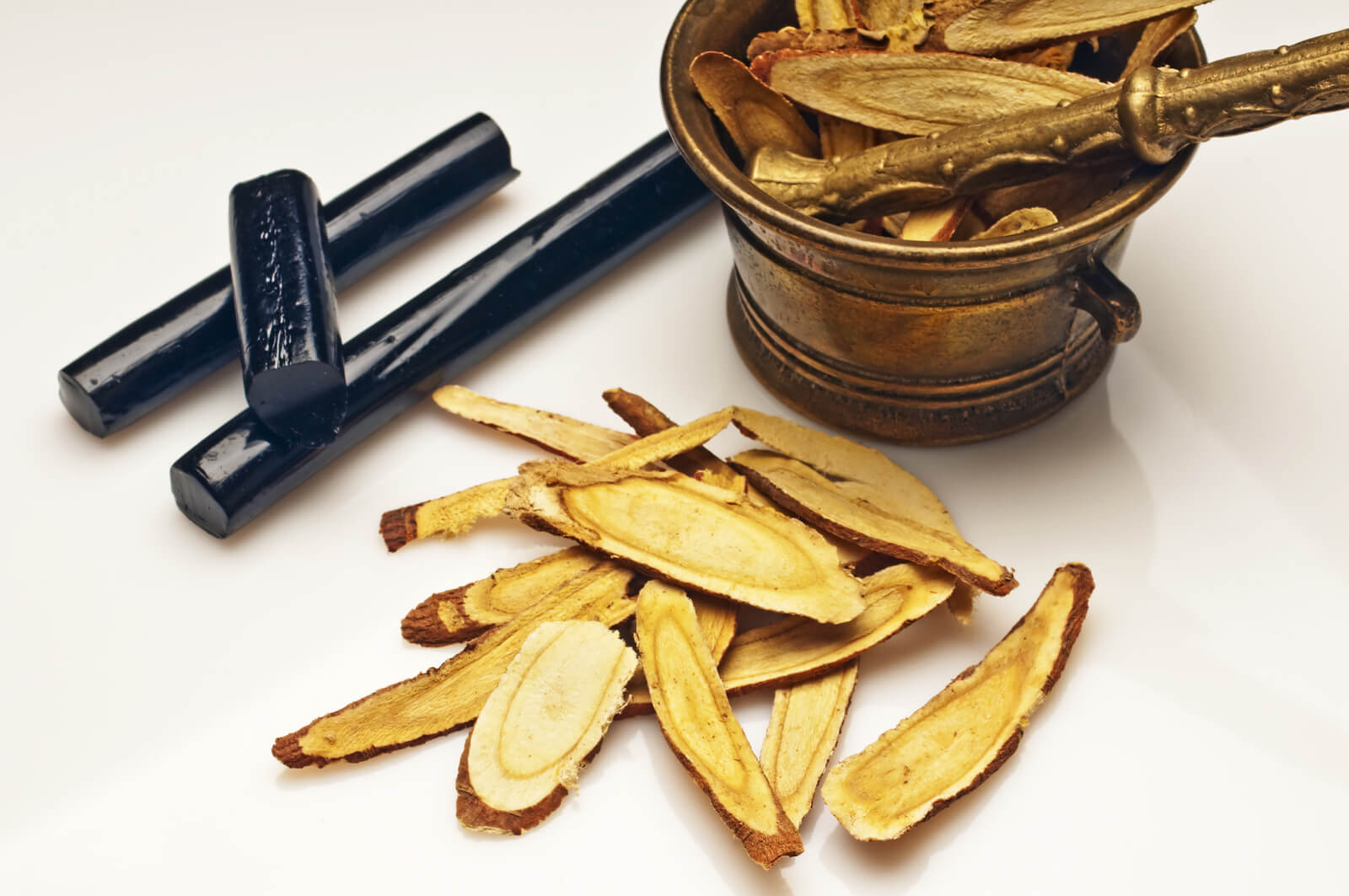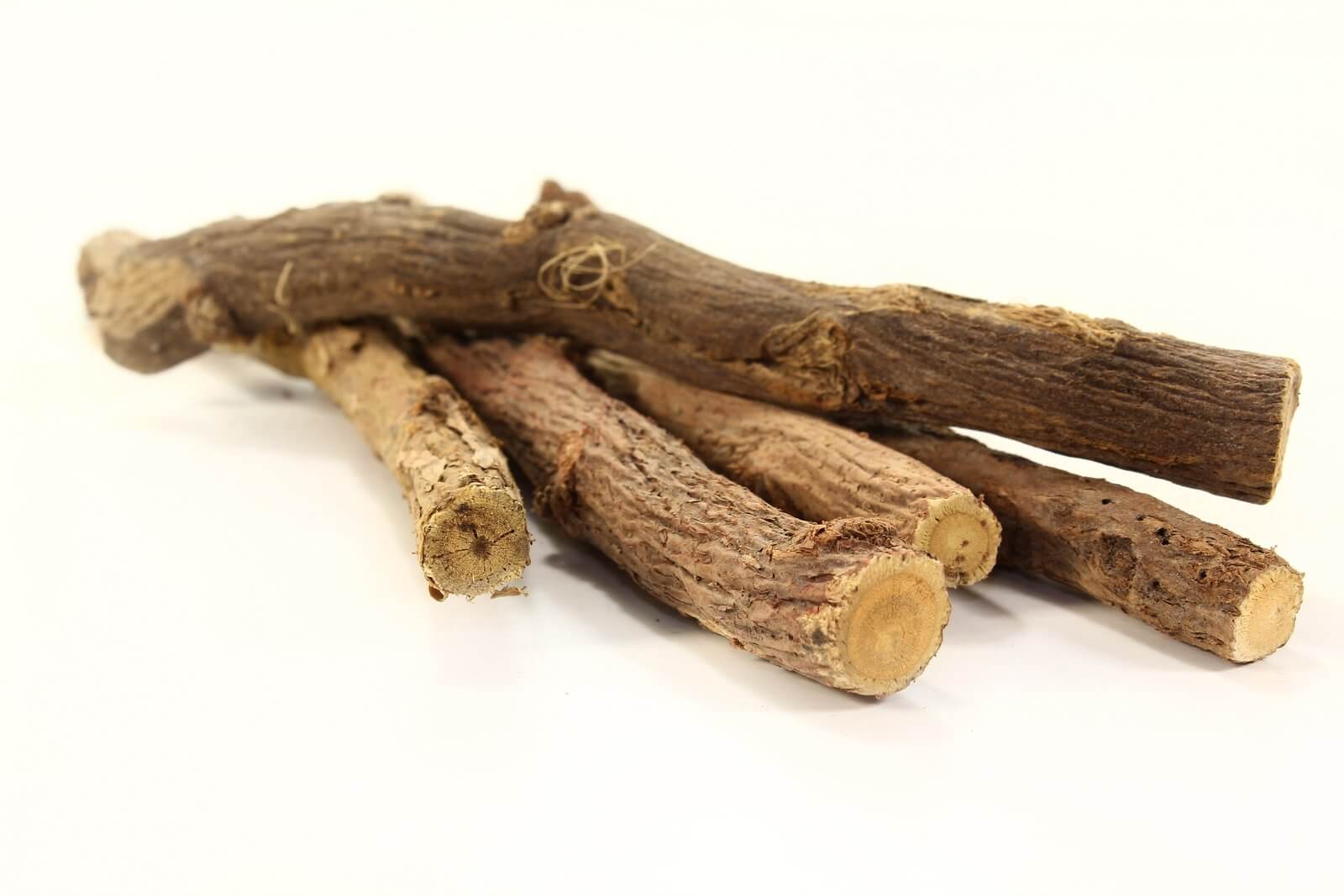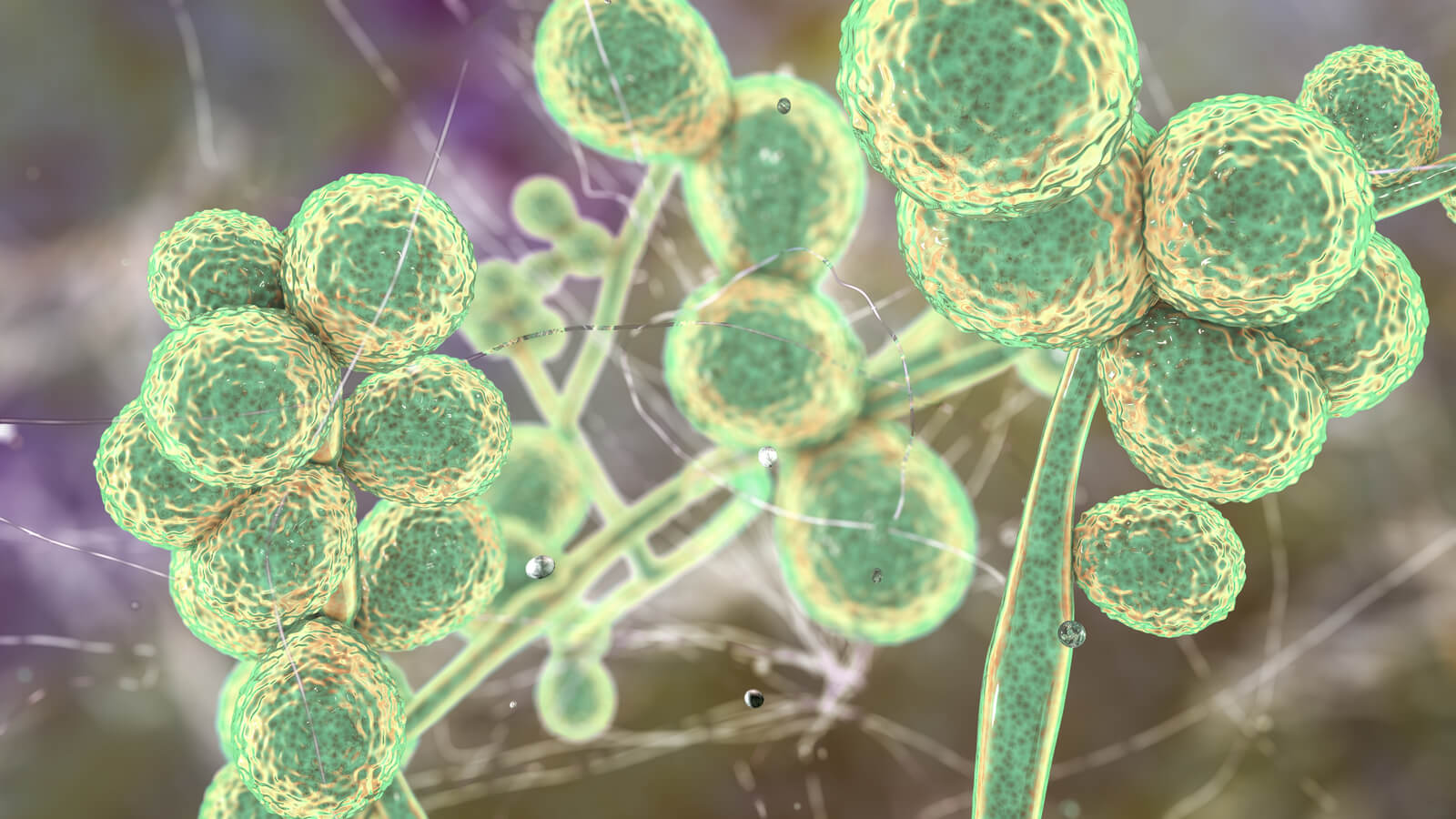See all "Herbs" Section Topics

Licorice (Glycyrrhiza glabra) has been used by people to treat a wide variety of health maladies for thousands of years. Licorice is used extensively in Ayurvedic and other traditional medicinal practices. In the ancient practice of Ayurvedic medicine, there are over 1250 remedies that use licorice as an ingredient. Many of these ancient remedies have been used successfully in various infectious conditions. Even western medicine has utilized this medicinal herb to treat various diseases. Some of its uses include acting as a demulcent, expectorant, and coating agent. In addition to its many medicinal uses, licorice root is a powerful antifungal; and, contains several different chemicals that disrupt fungus—about 25 different compounds to be more specific. Consequent to its phytochemical makeup, licorice root is a great herbal remedy for yeast infections.
Standard Protocol for Internal Use
- Dried Licorice Root: one to five grams as a decoction or infusion taken 3 times daily.
- Licorice Root Tincture: mix one part licorice root with five parts water, take 5 mL 3 times daily.
- Licorice Root Extract: take 250 to 500 mg 3 times daily (use standardized extracts that contain 20% glycyrrhetinic acid).
Using Licorice Root Topically

You should be able to safely use some ground licorice root powder in a vaginal douche or carrier substance, like oil or honey. Simply add the ground licorice root in and apply it where you have Candida causing problems. As the studies below will prove, it only takes a little of this herb to start getting rid of noxious yeast. You can also make a strong decoction of licorice root powder and apply it topically to the infected area. Just add 5 to 7 teaspoons of powdered licorice root to a cup of boiling water and let it simmer for about 20 minutes. When the simmering is done, take a cotton ball and use it to apply the liquid to your body. Do this one to three times a day. You can also use it as a vaginal douche. Try adding a little apple cider vinegar to the water to make the decoction an even better remedy! Make sure you do not use too much apple cider vinegar; keep the concentration of the vinegar at 1%. Undiluted vinegar can cause skin irritation and even chemical burns if it is in contact with the skin long enough or frequently enough. You can find out more information about this vinegar here: Apple Cider Vinegar for Yeast Infection.
A 1/2 Day & Yeast is Gone!
Linda Allen suffered from yeast infections for years. Through researching natural medicine & Candida, she found an efficacious solution!
Linda is one expert you want on your side! Let her show you how to get rid of a superficial yeast infection in just 12 hours; AND, keep it gone!
A 60-day, 100% money back guarantee is provided.
Visit Official Site!Licorice and Candida albicans Research

The first study we will examine, was published in Phytotherapy Research [23.4 (2009): 572-574]. The study looked at an acid present in licorice root, known as 18-beta glycyrrhetinic acid (18-beta GA), and how it affected Candida albicans. According to Dr. James Duke’s phytochemical database, this acid is present in licorice root in the amounts of 39,800 ppm to 168,000 ppm. Parts per millions (ppm) is rather hard to conceptualize, so let’s put that in grams per liter! This works out to about 40 grams per liter to 168 grams per liter. And of course, these figures are dealing with an entire liter of licorice root. There is likely to be some differences in the amount of 18-beta GA present in each individual licorice root. If your licorice root product is made from multiple roots, there is likely to be more of an average amount (between these two extremes) of 18-beta GA in your product.
The study found that low amounts of 18-beta GA rapidly reduced the growth of Candida albicans when tested in vitro (i.e., tested in glass). The study found it took about 6.2 mcg / mL of 18-beta GA to start inhibiting Candida albicans. Since there is approximately, at the minimum, around 40 mg of 18-beta GA per mL of licorice root, you are likely to greatly exceed the tiny amount of 6.2 micrograms needed to inhibit Candida albicans.
Another study, published in the Journal of Applied Sciences Research [October (2009): 1436-1439], also looked at how licorice root extracts would affect Candida albicans. The study used various fractions of licorice root derived from exposing licorice root to various chemical solvents. Initially, an 80% ethanol solution was percolated through dried licorice root; all other fractions were derived from this initial ethanol licorice root extract. The crude ethanol extract of licorice root was able to inhibit the development of Candida albicans at a minimum level of 1.61 mg / mL. This means that when you use this herb topically, it should be easily able to halt the development of Candida albicans.
Licorice Root Halts Candida Biofilm and Hyphal Growth

Another study, published in Mycoses [54.6 (2011): e801-e806], is very interesting and relevant to yeast infections. The study examined how chemical compounds present in licorice stop the hyphal growth (germ tubes that grow into your skin) and biofilm formation (biofilm, when present, increases the resistance of Candida to some antifungal drugs by over 1000 times). These two activities, biofilm formation and hyphal growth, greatly increase the virulence of Candida albicans (the species responsible for about 80% of all Candida infections); thus, they are very relevant to see how well any treatment will work.
The study found that 100 mcg / ml of licochalcone A or glabridin significantly reduced Candida albicans hyphal growth—reducing this growth by over 80%. Biofilm formation by Candida albicans was reduced 35–60% in the presence of 0.2 mcg / ml of licochalcone A. According to Dr. Duke’s phytochemical database, there are approximately 250 ppm of licochalcone A in licorice root. This means that there are about 250 mcg / mL of licochalcone A in licorice root. Dr. Duke’s database also says there is between 400 ppm and 4000 ppm of glabridin in licorice root. This means a milliliter of licorice root will contain more than enough of these compounds to generate these same anti-Candida effects where it is applied. Thus, you should see the same results as you generously apply licorice root to your vagina or infected skin.
The study states this in summary of the ability of licorice to stop Candida albicans:
In summary, glabridin and licochalcone A are potent antifungal agents and may act in synergy with nystatin to inhibit growth of C. albicans. Licochalcone A has a significant effect on biofilm formation, while both licochalcone A and glabridin prevented yeast-hyphal transition in C. albicans. These results suggest a therapeutic potential of licochalcone A and glabridin for C. albicans oral infections.
http://dx.doi.org/10.1111/j.1439-0507.2011.02028.
Glycyrrhizin and Candida albicans
A study, published in Clinical & Experimental Immunology [1999; 116:291–298], found an interesting ability of one of the primary active chemical components of licorice root: glycyrrhizin. The study found that in vitro (in glass; i.e. not in a living organism), glycyrrhizin did not stymie the development of Candida albicans. However, when administered to mice, their T-cells were much better at protecting mice from Candida albicans. Mice who were inoculated with Candida albicans received T-cells from mice treated with glycyrrhizin. As a control, T-cells from mice not treated with glycyrrhizin were also injected into mice inoculated with Candida albicans. The study found that mice who received a certain type of T-cell from glycyrrhizin treated mice had about 90% to 100% survival rate; those mice that did not receive such T-cells all died.
The lack of ability of glycyrrhizin to stymie Candida albicans in vitro, and the drastic change in survival rate due to glycyrrhizin affected T-cell transplants, indicate that glycyrrhizin acts on the immune system cells and augments their Candida fighting ability. Consequently, licorice may be very beneficial to take internally as well as using it topically to bolster the body’s immune response to Candida overgrowth.
Eliminate Bacterial Vaginosis & Vaginal Odor
Jennifer O’Brien is one prominent expert on BV that knows how to get rid of vaginal odor. BV is a common infection that you don’t have to put up with.
Jennifer will show you how to naturally eliminate vaginal odor in just 3 days.
A 60-day, 100% money back guarantee is provided.
Visit Official Site!Side Effects of Using Licorice Root

Individuals with heart problems may want to avoid ingesting licorice; or, consult a physician before they take it internally. Licorice contains glycyrrhizin, and too much of this chemical can lead to pseudoaldosteronism—which causes over sensitivity to a hormone in the adrenal cortex. This in turn leads to high blood pressure, and can cause heart attacks. Headache and fatigue can also result from this condition. Typically, ingesting large amounts of licorice will cause these conditions; but, there is a chance that ingesting smaller amounts will result in some side effects.
In addition to heart problems, ingesting licorice while you are taking corticosteroids, diuretics, or drugs that lower potassium levels can lower the potassium levels of the body to unsafe amounts.
Taking large amounts of licorice can also manipulate the body’s level of a hormone called cortisol. Additionally, pregnant women should avoid taking licorice internally, as some research indicates it may lead to preterm labor.
In general, do not take large amounts of licorice root internally. Stay within the safe internal doses and use it mainly externally in a douche or topical treatment. This should be a safe way to get rid of a yeast infection without risk of unwanted side effects.
Clair Goodall: Author & Nature Lover
Clair Goodall is a bee-obsessed natural medicine convert from Minnesota. She is one expert you might want to know more about!
Clair will help you protect you and your family from toxic products and chemicals and help you discover solutions from nature.
Also, Clair’s book is backed by a 60-day, 100% money back guarantee
Visit Official Site!A Natural, 12 Hour Yeast Infection Cure

According to a research paper published in Clinical Microbiology Reviews [12.1 (1999): 80-96], Candida species are quite ubiquitous organisms. Candida are most frequently present in the mouth; and, live in 31% to 55% of healthy people. The species that causes approximately 70% to 80% of all Candida infections is C. albicans.
The Chinese Journal of Obstetrics and Gynecology [2011 Jul;46(7):496] reports there appears to be a correlation between intestinal Candida infections and vaginal yeast infections. And, this provides a clue, as to why yeast infections in general, can reoccur.
This study states, in 148 cases of vaginal candida infections, 33.1% of the women were infected in both the intestines and vaginal area. The recurrence rate of yeast infections, in women with simultaneous intestinal infection, was significantly higher than for women who did not have an intestinal infection. This study concluded that vaginal yeast infections are highly associated with simultaneous intestinal Candida infection.
As research appears to indicate, systemic Candida infections can and do happen. A more systemic Candida infection may primarily get a foothold in the intestines; and cause a wide array of problems. If your yeast infections keep happening, a systemic Candida problem may be why.
One woman who suffered from a systemic Candida infection, for about 12 years, was Linda Allen. The systemic Candida infection that attacked Linda caused a wide range of health problems in addition to yeast infections. Some of these problems, Linda describes in her own words in the following quote:
To be honest, it was hard to pinpoint exactly what was wrong: I wasn’t really sick, but I wasn’t really well either. I had listlessness, fatigue, brain fog, stomach ailments, unexplained rashes, skin infections, and so on. It seemed like every day brought a new challenge.
My energy was sapped and I felt exhausted, which affected my grades and put a big dent in my social life.
Linda Allen’s symptoms included an embarrassing vaginal discharge, severe itching, and burning sensations. Her infections were difficult to deal with, and Linda’s health problems cost her financially as well. Linda states these infections of Candida can become excruciating when they happen as frequently as a menstrual period.
Yet, Linda spent a great deal of time in research; and even questioned health professionals who were kind enough to share some time with her. Linda even tried an array of purported "cures." Although it took a while, eventually, Linda put together a natural treatment plan she hoped would solve her Candida situation.
After spending about a year refining her new approach, Linda tried her system on herself. It worked amazingly well. Linda even returned to a few medical doctors to get tested for the presence of infections. These tests revealed all indicators of infection had vanished! Linda was indeed well again, after such a long, difficult journey.
Linda has since published a book detailing how to copy her success. She also includes a 12 hour yeast infection cure that can get rid of a superficial (such as a genital yeast infection or oral thrush) yeast infection in about 12 hours.
Linda’s publisher protects those who get her book with a 60 day, 100% money back guarantee. Linda’s publisher, a subsidiary of the United States based firm Keynetics Incorporated, is a reputable digital retailer that has been around for a long time. They have great customer service, and make getting a full refund on Linda’s book quick and easy. If you’re not satisfied, you can quickly get all your money back.
If you would like to learn more about Linda’s journey to freedom from Candida, see reviews of others who tried her natural system, or find out more about her efficacious book; you can find more information at Linda Allen’s website.
Author: Mr. Nicholas Gross

Nick Gross is a natural medicine enthusiast who has been researching and writing about natural medicine since 2008. Nick is primarily a web developer but also researches and authors written and video content about natural health. Nick has a bachelor’s degree in Management Information Systems from the University of Northern Iowa.
Disclaimer
The information on this website is not a prescription for anyone. This information is for informational or educational purposes only, and is not a substitute for professional medical advice or consultations with healthcare professionals.
Affiliate Disclosure
Some of the links provided on this website are affiliate links. When a purchase is made through these links, Candida Hub earns money from commission. This helps to keep the website up and helpful to people for free. Thank you for any support!
Stay Up to Date
If you enjoyed this article, consider following / liking our Facebook page. This page is primarily utilized to alert followers of new articles that are put on Candida Hub. Candida related news is also discussed. While you are there, you can see what has been more recently added to Candida Hub.
SOURCES:
- https://nccih.nih.gov/health/licoriceroot — Licorice root fact sheet
- https://umm.edu/health/medical/altmed/herb/licorice — University of Maryland Medical Center licorice fact sheet
- Google Books — Duke, J. A. (1997). The green pharmacy: New discoveries in herbal remedies for common diseases and conditions from the world's foremost authority on healing herbs. Emmaus, Pa: Rodale Press.
- http://dx.doi.org/10.1002/ptr.2693 — Pellati, Donatella, et al. "In vitro effects of glycyrrhetinic acid on the growth of clinical isolates of Candida albicans." Phytotherapy Research 23.4 (2009): 572-574.
- Dr. Duke's Phytochemical and Ethnobotanical Databases
- http://dx.doi.org/10.1111/j.1439-0507.2011.02028.x — Messier, Céline, and Daniel Grenier. "Effect of licorice compounds licochalcone A, glabridin and glycyrrhizic acid on growth and virulence properties of Candida albicans." Mycoses 54.6 (2011): e801-e806.
- http://www.aensiweb.com/old/jasr/jasr/2009/1436-1439.pdf — Meghashri, Shubha Gopal. "In vitro antifungal and antibacterial activities of root extract of Glycyrrhiza glabra." Journal of Applied Sciences Research October (2009): 1436-1439.
- http://ijcmas.com/vol-3-1/Korhalkar%20Anagha,%20et%20al.pdf — Anagha, Korhalkar, et al. "Antimicrobial activity of Yashtimadhu (Glycyrrhiza glabra L.)-A Review." Int. J. Curr. Microbiol. App. Sci 3.1 (2014): 329-336.
- http://www.ncbi.nlm.nih.gov/pubmed/10337021 — Utsunomiya, T., et al. "Effects of glycyrrhizin, an active component of licorice roots, on Candida albicans infection in thermally injured mice." Clinical and experimental immunology 116.2 (1999): 291-298.
- https://doi.org/10.1128/CMR.12.1.80 -- Fidel, Paul L., Jose A. Vazquez, and Jack D. Sobel. "Candida glabrata: review of epidemiology, pathogenesis, and clinical disease with comparison to C. albicans." Clinical Microbiology Reviews [12.1 (1999): 80-96].
- https://pubmed.ncbi.nlm.nih.gov/22041440/ -- Lin XL, Li Z, Zuo XL. "Study on the relationship between vaginal and intestinal candida in patients with vulvovaginal candidiasis." Chinese Journal of Obstetrics and Gynecology (Zhonghua fu chan ke za zhi). [2011 Jul;46(7):496].







